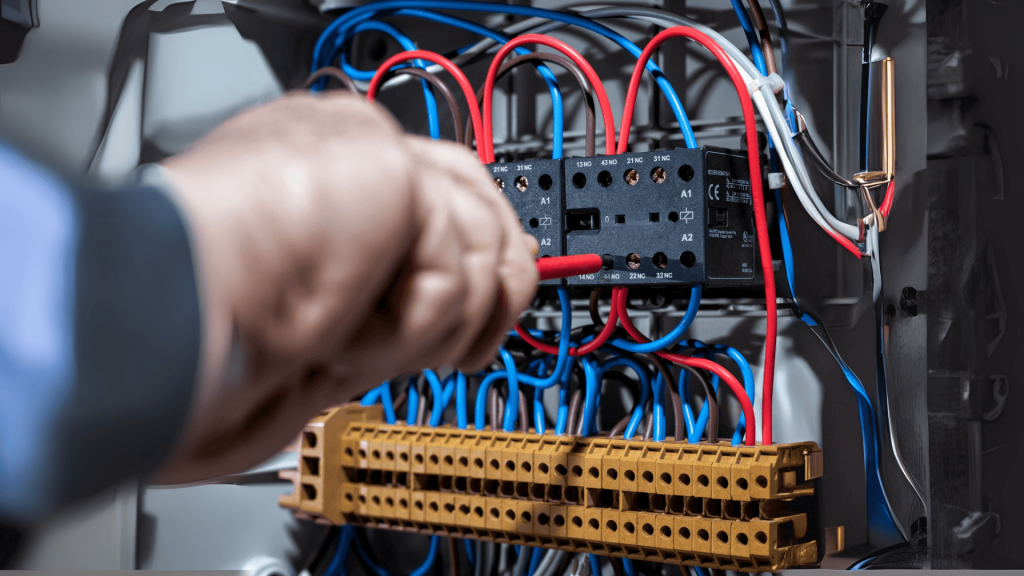Repair & Servicing
Repair & Servicing refers to the maintenance, troubleshooting, restoration, and optimization of electrical, mechanical, and electronic systems to ensure they operate efficiently and safely. This process is essential across industries to minimize downtime, extend equipment lifespan, and ensure compliance with safety and performance standards..
Key Aspects of Repair & Servicing
- Preventive Maintenance
- Scheduled inspections and routine servicing to detect and correct potential issues before they cause breakdowns.
- Activities include:
- Cleaning of components
- Lubrication of moving parts
- Tightening electrical connections
- Calibration of sensors and meters
- Testing protective relays and safety devices
- Corrective Maintenance (Repair)
- Unplanned repairs carried out when a fault or failure has occurred.
- Involves:
- Troubleshooting and fault diagnosis
- Replacement of defective components (e.g., fuses, relays, sensors)
- Repairing electrical circuits, mechanical parts, or automation systems
- Reprogramming or updating control systems (PLCs, HMIs)
- Predictive Maintenance
- Uses data-driven monitoring tools and analytics to predict failures before they occur.
- Techniques include:
- Vibration analysis
- Thermal imaging (infrared thermography)
- Ultrasonic testing
- Power quality analysis
- Annual Maintenance Contracts (AMC)
- Long-term service agreements between service providers and clients to ensure regular maintenance and priority support.
- Typically includes:
- 24/7 emergency service
- Periodic system health checks
- Spare parts management
- Technical support and consultation
Systems Commonly Serviced
- Electrical Systems
- Switchgear & panels
- Transformers
- UPS & batteries
- Cabling & wiring
- Earthing systems
- Automation & Control Systems
- PLCs, SCADA, DCS
- Sensors, actuators
- VFDs (Variable Frequency Drives)
- Industrial robots and motors
- Power Systems
- DG sets (Diesel Generators)
- Solar inverters and PV systems
- Battery storage systems
- Mechanical Systems
- HVAC systems
- Elevators/lifts
- Pumps and compressors
- Lightning Protection Systems
- Testing of grounding systems
- Inspection of air terminals and conductors
Benefits of Regular Repair & Servicing
- Minimizes Downtime
Quick repair reduces production losses and improves business continuity. - Enhances Equipment Lifespan
Prevents premature wear and failure of critical components. - Improves Safety
Identifies hazards like short circuits, insulation failures, and overloads before accidents occur. - Boosts Efficiency
Ensures systems operate at peak performance with optimal energy use. - Regulatory Compliance
Helps businesses meet safety and performance standards (e.g., ISO, OSHA, NEC). - Cost Savings
Reduces the need for expensive emergency repairs and full system replacements.
Tools & Techniques Used
- Multimeters & Clamp Meters
For basic electrical diagnostics - Insulation Resistance Testers
To check cable insulation health - Thermal Cameras
For spotting overheating components - Diagnostic Software
For automation systems, PLCs, and SCADA - Vibration Meters
For mechanical condition monitoring - Load Testers
For batteries and generators
Repair & Servicing is a cornerstone of operational reliability and safety. Whether it’s a high-end industrial automation system, a transformer, or a simple motor, regular maintenance and quick repair ensure long-term performance, minimize disruptions, and extend the life of critical infrastructure.

